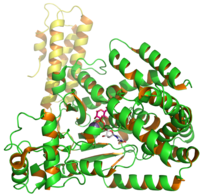
Photo from wikipedia
Clostridium difficile is a major cause of hospital-acquired antibiotic-associated diarrhea. C. difficile produces two cytotoxins, TcdA and TcdB; both toxins are multidomain proteins that lead to cytotoxicity through the modification… Click to show full abstract
Clostridium difficile is a major cause of hospital-acquired antibiotic-associated diarrhea. C. difficile produces two cytotoxins, TcdA and TcdB; both toxins are multidomain proteins that lead to cytotoxicity through the modification and inactivation of small GTPases of the Rho/Rac family. ABSTRACT Clostridium difficile is a major cause of hospital-acquired antibiotic-associated diarrhea. C. difficile produces two cytotoxins, TcdA and TcdB; both toxins are multidomain proteins that lead to cytotoxicity through the modification and inactivation of small GTPases of the Rho/Rac family. Previous studies have indicated that host glycans are targets for TcdA and TcdB, with interactions thought to be with both α- and β-linked galactose. In the current study, screening of glycan arrays with different domains of TcdA and TcdB revealed that the binding regions of both toxins interact with a wider range of host glycoconjugates than just terminal α- and β-linked galactose, including blood groups, Lewis antigens, N-acetylglucosamine, mannose, and glycosaminoglycans. The interactions of TcdA and TcdB with ABO blood group and Lewis antigens were assessed by surface plasmon resonance (SPR). The blood group A antigen was the highest-affinity ligand for both toxins. Free glycans alone or in combination were unable to abolish Vero cell cytotoxicity by TcdB. SPR competition assays indicate that there is more than one glycan binding site on TcdB. Host glycoconjugates are common targets of bacterial toxins, but typically this binding is to a specific structure or related structures. The binding of TcdA and TcdB is to a wide range of host glycans providing a wide range of target cells and tissues in vivo.
Journal Title: Infection and Immunity
Year Published: 2018
Link to full text (if available)
Share on Social Media: Sign Up to like & get
recommendations!